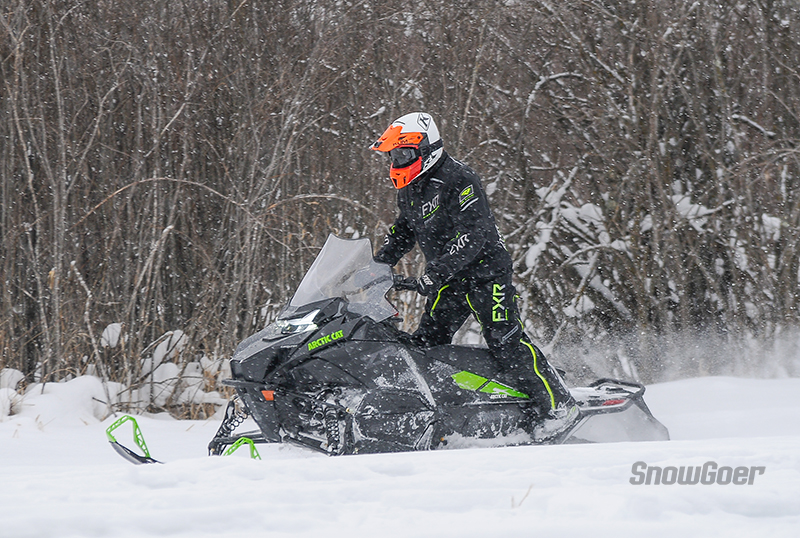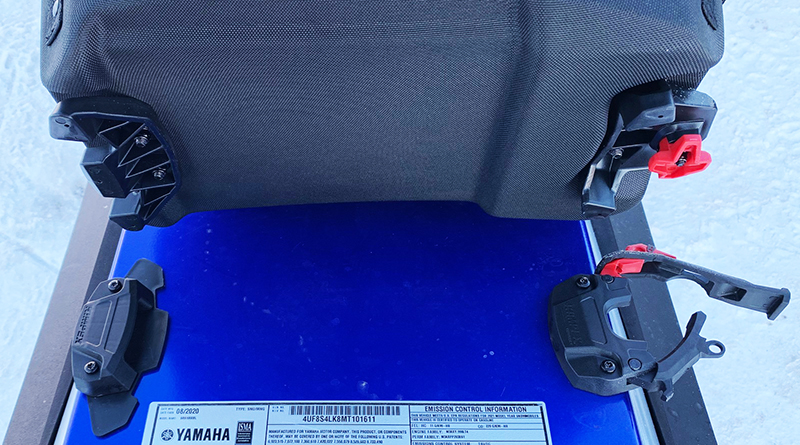
If you want to climb aboard a single-ski backcountry slayer designed for unmatched rider confidence and control, the 2018 Timbersled ARO 137 LE is definitely worthy of consideration. The narrow aluminum platform is catered to provide immediate lift in powdery snow – courtesy of a raised drive shaft – paired with swift, responsive handling. It allows a dirt bike with an ARO kit attached to knife through the trees and glide across the snow like a football running back darting through linemen and dodging tackles en route to a touchdown. The whole experience became even better when we added the accessory Trio shock to the front end
Snowbikes have been rapidly gaining popularity in the last half-decade, but the dirt-to-snow conversion process has plagued many snowbikers throughout the years, with some opting to leave a dedicated snowbike set up for one season, then have a second bike to ride in the dirt. Beyond the actual wheel swap and brake system bleeding, oftentimes it’s not just the kit installation that requires extra time but also the accessories like air intake, foot peg and fork spring change, handlebar swap or even installing a snow-specific ECU tune.
With the design of the new ARO kit, Timbersled set its sights on being the easiest and quickest system to convert a chosen dirt machine into a snow donkey. The rear of the kit installed similar to prior years, fitting the Timbersled frame between the bike frame and the engine case. The strut rod (or in our case, the Timbersled Suspension Strut rod end) installs via a trunnion ball lower mount and readily attaches the lower rod end to the top of the kit. The pre-bled brake system was an instant and welcomed improvement – as we’d later find out, the shielded caliper setup and positive lever feel produced a brake that will slow the track and lock it up via simple, single-finger actuation.
Another improvement was the frontend swap: The old Mountain Horse spindles required drilling to line-up the fork clamps for varied brand bikes with different-sized bosses around the lower fork leg. The ARO spindle requires no drilling and instead showcases slotted grooves to universally fit various bike brands.
The Traverse ski being wider than prior years was an instant bonus – it floated better, was more positive when laid over and never wanted to slip-out on side-hills. However, it took time getting used to during early season rides where frozen, snow-covered ruts left by ATVs made it so the combination of turning and leaning would start to hook the inner runner, twisting a rider to the ground.
The ski’s center keel also stuck firmer to wood when passing over hidden logs or tree roots on the trail, often jarring the rider. After examining the underside of the ski, we opted to grind away the leading edge of each runner so we could attack obstacles less violently and glide instead of gouge. We chose correctly, and the small plywood edge of the trailer door was evidence of success.
Relative to the prior Mountain Horse from Timbersled, the adjusted ARO skid frame and suspension geometry greatly improved the ride in rough conditions. The new design delivers 30 percent more front shock travel resulting in 2 inches of increased total travel, and it shows. Grabbing gears and hanging on with the throttle open was possible with the LE versions of the Mountain Horse, but this ARO now blips through more sections more easily by staying connected to the ground more effectively.
Between the aggressive terrain found when crossing blown-in ravines or around trees to the sections of un-groomed single track used to access riding areas, the suspension absorbed more so your body was less distraught after a ride. While the factory-delivered rear spring preload settings worked flawlessly for our mountainous adventures, what’s more impressive is how the springs’ customization can greatly affect the ARO’s transfer for varied rider weights or feel. The clickable Fox QS3 shocks on this LE took it to the next level to create the ultimate tunable ride.

We opted for an upgrade on our ARO package, utilizing the Timbersled Suspension Strut shock system under the seat to give 70 percent increased travel versus the fixed strut. This not only more easily absorbed sharp-edged, jostling bumps, but the front end became lighter, more playful and, most importantly, more fun.
Driving it all was the impressive new Traverse track. We’ve been aboard single skiers since the Timbersled inception in 2011 and have witnessed every track improvement through the years.
While the 2015-16 adaptation from the 2- to 2.5-inch Convex version is still the most drastic advancement in snowbike traction, the 11.5-inch wide Traverse system is no slouch. It may be 1-inch narrower than its predecessor, but it moves just as much snow to propel the bike in the deepest fluff it can find. The secret sauce is likely found in the 2.5-inch center lugs, which are wider than similar lugs on the old Convex design, plus the Traverse track’s slimmed pro_ le makes it easier to lay side-to-side for tight turning.
A month-long span of over-the-fender powder last winter really put the system as a whole to the test, and we gave it a superb rating. Breaking trail for friends stuck on sleds and blasting past others who were stuck climbing small hills further validated that Timbersled is at the top of its game with the ARO.
Mid-season adjustments to loosen the track tension provided smoother operation and freed additional horsepower. Tightening the engine chain was also fairly easy with the new adjustment system. The jam nut and adjuster played nicely, but accessing the 15 mm locking bolts under a bike with long side-panels and a hefty exhaust silencer became slightly awkward, especially when adjusting when the bike was warm.
A Key Addition
In the same year Timbersled unveiled the new ARO track and ski kit there are also new accessories to also try out – one of which was the Trio shock.
At its core, the Trio shock is a very long Fox FLOAT shock with an EVOL chamber that integrates into the ski suspension. Add in proprietary valving that is extremely sensitive to speed and this system aims to eliminate the need to swap fork springs within the dirt bike for a stiffer winter setup, or the need to adjust valving.
Installation took less than 10 minutes, and even less time to insert the suggested air pressure settings. The recommended 20 psi in the main chamber and 30 psi in the EVOL instantly made their presence known over a normal, pre-Trio ride during four days on the snow.
With the Trio in place, the suspension didn’t use its entire stroke as easily in hard hits, and the fender didn’t sag toward the snow in gentle cruising. As the season changed snow became firmer and desire to fly off jumps grew, and it became evident that we’d like to use all of the stroke in our forks, so we decreased the main pressure to 10 psi while increasing the EVOL to 50 psi – creating a bike that we loved even more.
Editor’s Note: Every Snow Goer issue includes in-depth sled reports and comparisons, aftermarket gear and accessories reviews, riding destination articles, do-it-yourself repair information, snowmobile technology and more. Subscribe to Snow Goer now to receive print and/or digital issues.






